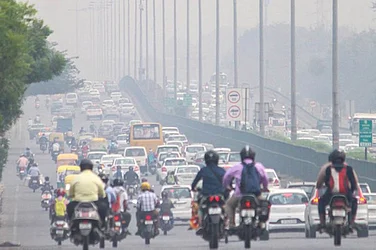After over two years of the first Covid-19 infection in China's Wuhan city and over 50 crore infections and 60 lakh deaths across the world, the world does not know how SARS-CoV-2, the virus that causes Covid-19 disease, emerged and led to the pandemic.
The World Health Organization (WHO) on Thursday released a report saying "key pieces of data" to explain how the pandemic began are still missing and the WHO is "open to any and all scientific evidence that becomes available in the future to allow for comprehensive testing of all reasonable hypotheses", according to AP.
It quoted Jean-Claude Manuguerra, the co-chair of the 27-member advisory group behind the report, as saying that some scientists might be "allergic" to the idea of investigating the lab leak theory and they needed to be "open-minded" enough to examine it.
This is a sharp reversal of WHO's earlier position saying Covid-19's lab-origin is "extremely unlikely". The WHO has been under severe criticism for over two years for prematurely junking the possibility of a lab-origin and for taking Chinese government's words for granted.
Besides the WHO report, the US intelligence community that investigated the Covid-19 origin at the order of US President Joe Biden had indicated a possibility of lab-origin. There have been investigative journalistic reports that have highlighted that Chinese researchers in Wuhan were doing 'gain-of-function' research that many fear might have caused an accidental outbreak.
Here we explain the Chiense research work, the WHO's report, earlier reports on Covid-origin, and accusations on the Chinese state of cover-ups.
What WHO has said on Covid origin
Last year, the WHO had said a lab-origin is highly unlikely when a 17-member international team went to China to study Covid-19 origin.
WHO's Dr Peter Ben Embarek had said that the findings of WHO's 17 experts, joined by 17 Chinese epxerts, suggested that "laboratory incident hypothesis is extremely unlikely to explain introduction of the virus into the human population".
It is in the backdrop of this comment, and other comments by a number of international figures initially dismissing the possibility of Covid-19 lab-origin, that WHO's Thursday's report is important.
"All hypotheses must remain on the table until we have evidence that enables us to rule certain hypotheses in or out," said WHO Director-General Tedros Adhanom Ghebreyesus.
What's lab-origin case
Simply speaking, the case is this — scientists at Wuhan were carrying out research on coronaviruses and the virus accidentally escaped the lab, leading to the first outbreak in Wuhan that spread to the rest of the world.
Several experts suppressed this possibility right at the start and for the most part of 2020, leading media organisations called it a conspiracy theory, with only few exceptions and few scientists and open-source investigators pursuing this line of thought.
From early 2021, however, reports began emerging about the extent to which Chinese scientists were carrying out 'gain-of-function' research in Wuhan and how they covered it up. It also emerged that Chinese government hid the initial outbreak for a long time which could have given the world more time to prepare if they would have been forthcoming.
The extent of the gain-of-function research, the Chinese cover ups, and the fact that despite denying a lab-origin for over two years, its critics can still not prove a natural origin has strengthened the case for the lab-origin.
What's gain-of-function research
Simply speaking, 'gain-of-function' research means taking a virus (like SARS or MERS) and modifying it in a lab to make it more lethal.
It should be noted here that there are hundreds of coronaviruses, but only seven including SARS-CoV-2 causing Covid-19 affect humans.
To understand the extent of such research, take this case: In 1990s, Ralph Baric and Boyd Yount of the University of North Carolina "trained" a mice coronavirus to infect hamsters, which means they made the virus infect a species that it wouldn't have infected naturally. They altered the nature of the virus to infect an entirely new specie.
The Chinese were collecting coronavirus samples and researching on them in Wuhan since at least 2010. Wuhan Institute of Virology's (WIV) Shi Zhengli, called 'Bat Woman' for her research on bat viruses, and her American collegue Peter Daszak published an account of 630 coronaviruses sampled between 2010-15.
Earlier in the pandemic, Zhengli wrote that Sars-CoV-2 closely resembled an earlier virus called RaTG13. But she didn't share much about it.
It was an Indian open-source investigator who unearthed that WIV had found RaTG13 in China's Yunnan province, as per Newsweek. The Indian investigator, who goes by the pseudonym The Seeker, found that the "genetic sequence for RaTG13 perfectly matched a small piece of genetic code posted as part of a paper written by Shi Zhengli years earlier, but never mentioned again".
Experts, including scientists Alina Chan, science writer Matt Ridley, and others, spent hours searching online for RaTG13, which was 96.2 per cent similar to SARS-CoV-2.
Later, it emerged that the Chinese had renamed RaTG13 as Bt-CoV/4991 in their records, which meant that unless someone looked very carefully, no one would draw the link. This meant that the Chinese had the closest ancestor of the virus causing Covid-19 in their lab for years, were aware of it, and they deliberately kept this information from the world.
Later findings would further put a question mark on Chinese researchers.
Where did the closest ancestor come from?
The RaTG13 virus came from a mine in China's Mojiang in Yunnan province. There, six miners cleaning bat guano fell ill and three of them died.
The Seeker found a Chinese student's thesis that described the miners' illness. The thesis said the illness was "caused by SARS-like [coronavirus] from the Chinese horseshoe bat or other bats". This thesis, and another thesis that The Seeker found, showed that four of these miners had tested positive for SARS-like anti-bodies.
When The Seeker shared this information publicly, the Chinese government shut down public access to its databases that had these documents.
To sum it up, the Chinese knew they had SARS-CoV-2's closest ancestor in their freezers which had caused deaths earlier. They renamed it which meant the world could not draw the connection. When discovered, they shut down their databses.
Later, when Zhengli and others published the account of 630 coronaviruses they sampled, the open-source investigators' collective DRASTIC went through them and found eight more viruses closely related to RaTG13 —which is closest to SARS-CoV-2— but Zhengli had not flagged it, reported Vanity Fair.
Chinese studied the virus all these years
Newsweek reported that data scientist Francisco de Asis de Ribera discovered that Chinese scientists were working on RaTG13 as late as 2018, adding that they made at least seven trips to the mine where the virus was discovered to collect thousands of samples.
Vanity Fair's Katherine Eban reported, citing US State Department sources: "Three researchers at the Wuhan Institute of Virology, all connected with gain-of-function research on coronaviruses, had fallen ill in November 2019 and appeared to have visited the hospital with symptoms similar to COVID-19."
The first suspected case of Covid-19 emerged in China on 17 November and the first confirmed case on 1 December, according to a timeline published by scientist Alina Chan and science writer Matt Ridley in their book VIRAL:The Search for the Origin of Covid-19.
This information in addition to fact that Chinese had not one but nine viruses very closely related to SARS-CoV-2 for years and they did not disclose it to the world poses further questions.
Katherine put it like this, quoting a US official: An institute funded by American dollars [WIV was working on US grants] is trying to teach a bat virus to infect human cells, then there is a virus in the same city as that lab. It is not being intellectually honest not to consider the hypothesis of a lab escape.
Burden of proof is on Chinese: Experts
For most part of the pandemic, experts have pushed those advocating the pursuit of lab-origin thesis to furnish proof. However, Alina and Matt in their book VIRAL wrote that the burden of proof should be on those advocating a natural origin in the light of all cover-ups by the Chinese.
They noted: "Much of the debate about the origin of the virus assumes that the laboratory-leak theory must prove itself. Natural spillover, by contrast, is the default assumption, which does not have to prove anything."
Alina and Matt added that the ball is now in the opponent's court.
They wrote: "Given the powerful circumstantial evidence that Wuhan was not a particularly likely place for a natural epidemic of a SARS-like virus to begin, but an obvious one for a laboratory-leaked one to start [because it has WIV that was researching on coronaviruses for years], it is surely reasonable to expect both hypotheses to be put to a similarly rigorous test."
Experts such as Alina and Matt advocating the pursuit of lab-origin thesis point out that they are not saying the virus originated in a lab but they are saying that it should be investigated just as seriously as the possibility of natural-origin.
They further highlight that while no conclusive evidence has come for natural origin, there is circumstancial evidence for lab-origin and the case therefore deserves to be pursued.


























